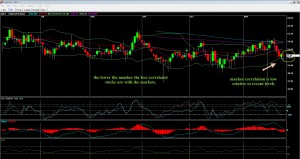This market has been ideal for stock pickers. How do I know that? Because market correlation is low and has been for nearly two years. Simply put, this means stocks can go up, down or sideways on their own merit without the influence of the macro. This is an important characteristic for a stock picker, and it’s also vital to a chartist. When I trade options, my first and last read is on the charts and technicals. Hence, if a stock or sector is strong but is getting beaten up by market forces, then it pretty much crowds me out of a trade.
Many futures and index traders love to see high correlation and volatility. This creates randomness without much predictability, making it open to anyone who wants to guess the direction. For those more skilled in price and profiling analysis, they’ll use a more methodical and systematic way to identify ranges. An astute and veteran options/futures trader like RMP contributor Bob Byrne is outstanding at finding levels, price points and volume areas that make his results enviable. There is no guessing here, just numbers, facts and statistics. However, not everyone has as much talent.
Option and stock trading require similar skills, but I tend to thrive under different conditions. For example, how do you explain a day when Apple goes up, Netflix is down and Facebook is flat? Aren’t stocks that are similar supposed to follow the same path? Not necessarily! See the chart below, which references implied correlation with the SPX 500. We look at market correlation in percentage terms, hence now the stock market is about 55% correlated with stocks. In this condition, we can see stocks moving on their own merit.
This is far different from what we saw in 2008-09, and more recently in 2011. During those times, markets mostly drifted lower but with violent swings, high volatility and challenging conditions. Remember how tough it was to play the markets on either side for any period of time? I spent a great deal of time in many of my accounts just on the sidelines – for months! That was not by design, but it just happened to turn out that way. Then in early 2012 the correlation bubble burst and stocks have been free to move on their own. As long as these conditions persist, I will trade accordingly. When they change, I will change.




















